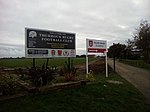Orsett Heath

Orsett Heath is a location and recently built hamlet in the unitary authority area of Thurrock, in the ceremonial county of Essex, England. It is located about twenty miles away from London. Nearby settlements include the towns of Tilbury and Grays and the villages of Orsett and Chadwell St Mary. For transport there is the A13 road, the A1089 road and the A1013 road nearby. The nearest railway station is Tilbury Town. At one time, Orsett Heath was probably part of a large swathe of heathland interspaced with woodland. This included Biggin Heath (heathland belonging to the manor of Biggin), Chadwell Heath (heathland belonging to the manor of Chadwell St Mary, not the place near Romford), Mucking Heath, Socketts Heath and Terrel's Heath all of which were on high ground compared to the nearby marsh and had poor sandy soil with underlying gravel and chalk.
Excerpt from the Wikipedia article Orsett Heath (License: CC BY-SA 3.0, Authors, Images).Orsett Heath
Heath Road, Thurrock
Geographical coordinates (GPS) Address Nearby Places Show on map
Geographical coordinates (GPS)
| Latitude | Longitude |
|---|---|
| N 51.4936 ° | E 0.3607 ° |
Address
Peaf's on the Heath
Heath Road 160
RM16 3AL Thurrock
England, United Kingdom
Open on Google Maps







